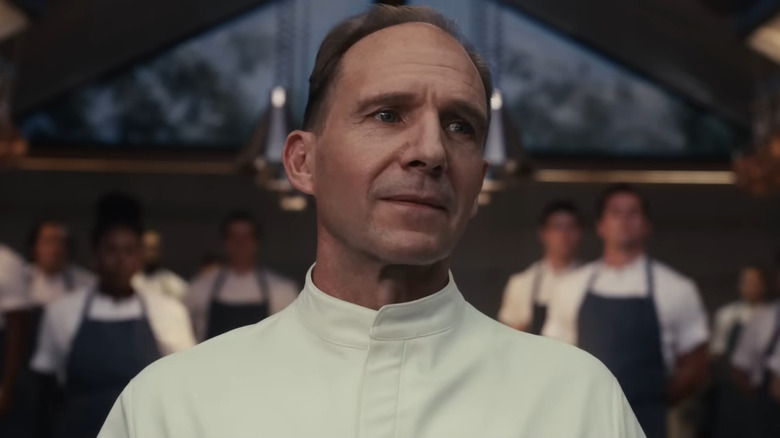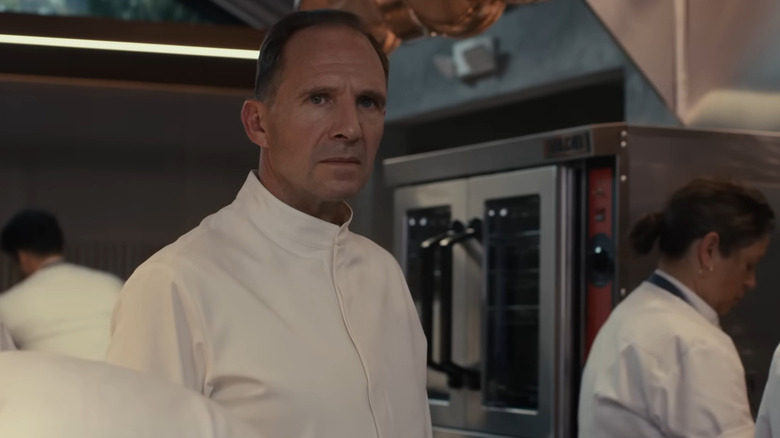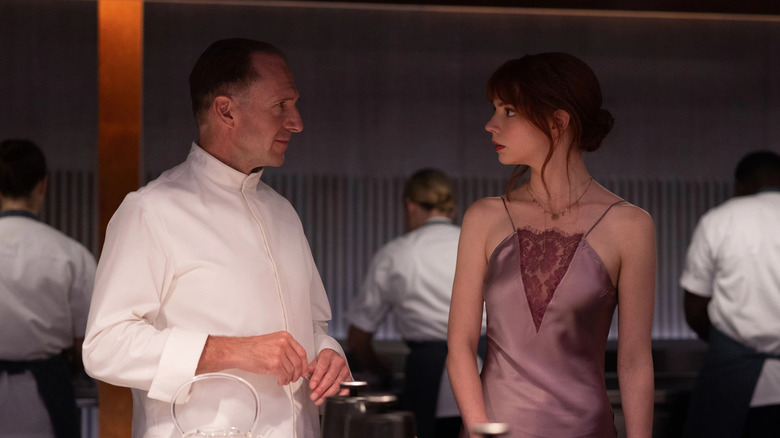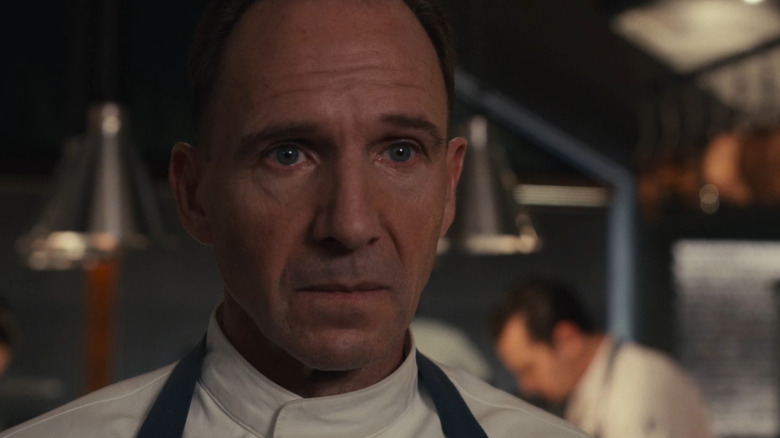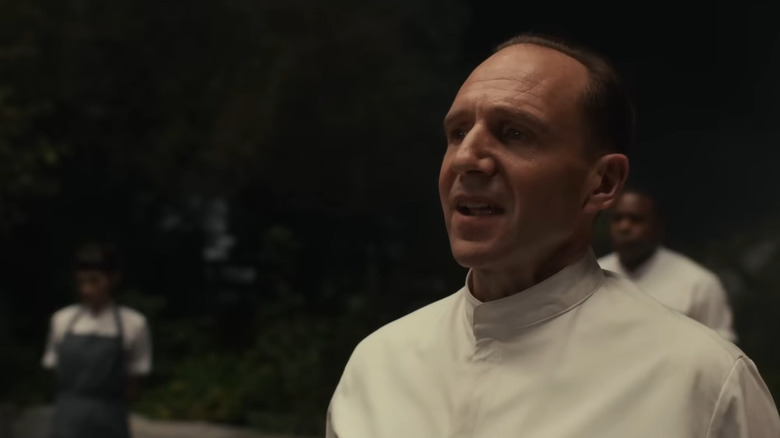How The Menu Pays Tribute To Food Service Workers
This article contains major spoilers for "The Menu."
You may not know what's about to happen, but once the diners board the boat to Hawthorne, something feels inherently off. Is it because this collection of wealthy foodies is about to indulge in a needlessly convoluted meal, or because something much more sinister lies in store for them? "The Menu" takes its time revealing its dark secrets, which makes for an experience as rewarding as a lavish course at your favorite restaurant. The hilarious dark comedy from director Mark Mylod gets to the meat of what it means to be dined on, and the privilege entailed within.
As far as satires go, "The Menu," which /Film's Chris Evangelista calls "delightfully wicked" in his review, takes great pleasure in messing with you. Think Luis Buñeul's "The Exterminating Angel" by way of those high-end establishments that sprinkle gold flakes on your food, and suddenly you're in the red for hundreds. It helps that the restaurant, which only takes 12 affluent consumers at a time, is located on a remote island away from the rest of the world. When you come to Hawthorne, you are at the mercy of Chef Slowik (Ralph Fiennes) and his dedicated kitchen staff.
From what we see, Slowik runs a very tight ship, where every meal is carefully constructed down to the finest detail no matter how absurd. As the plates get progressively weirder, it's revealed that Slowik and his crew have formed a murder/suicide pact, wherein they have chosen this group to go out with them, but not before one last extravagant supper that gets to the heart of their sins.
But a critical choice is made that I feel pays tribute to the chefs they were before being swallowed whole.
All accolades, no passion
As the night progresses, Slowik comes to the realization that he's become stagnant in his work. He's racked up so many accolades throughout his career, but it doesn't matter. The longer he's stayed complacent in the workforce that has built his legacy, the more he's become susceptible to its toxicity, whether it be workplace harassment, class displacement in his kitchen, or worse yet, the loss of his love for cooking.
The first time you watch "The Menu," you're with the diners, who are trying to figure out what the hell is going on. But on a subsequent viewing, once you know Slowik's plan, the film's perspective takes on an entirely different meaning. What starts as a one-location horror stage show becomes a sad lament configuration of a man whose industry has simply broken him. He recognizes his faults and privilege in cooking for rich losers all these years and decides to violently correct the course of the ship he's been sailing.
As Margot (Anya Taylor-Joy) notes, when the dishes arrive at the table, they're lifeless and largely unappealing. They favor exhibition over anything else, but it makes sense with the lesson Slowik is imparting to his unfortunate guests. Fiennes and Joy are the film's most compelling performances because these characters see right through one another. He sees a discreet escort worker at the mercy of a pathetic foody fanboy, which makes the stoic Chef feel concerned about her being there.
Slowik seems intent on taking her out with the rest of the trash, that is, until Margot requests a special order that not only reveals an enlightening truth, but also shows great consideration for food service workers.
Cheeseburgers ensure survival
Taking matters into her own hands, Margot throws Slowik off by performing his room-shaking clap and requesting a cheeseburger with crinkle-cut fries. Earlier in the film, she comes across Chef's house, in which his timeline of achievements is adorned on the wall. She sees the same thing we've already seen with Slowik's culinary descent into madness. But then she comes across the picture of Slowik in his humble beginnings as a fry cook. He looks happy and full of life, which is far and away from how we've seen the celebrity Chef throughout.
I love how Margot uses this to her advantage, both as a means of escape, and a means of giving Slowik some attempt at peace. She ultimately earns the respect of a revered individual by asking for something that a ludicrously overpriced establishment would see as beneath them. But at that moment, Margot figures that if Slowik is going to compile her in among the muck, she's going to take a piece of him with her. She breaks free from her diner counterparts by respecting the very nature of a dish that is affordable, class-conscious, and actually delicious.
In "The Menu," where the meals feature twisted, yet lifeless turns on frozen sea water and Beef Jus, cheeseburgers ultimately ensure survival. Each dish is born not out of love, but obligation in the plan, whether for Slowik's destructive pathway or because this is what these people actually like. At the moment when Margot "saves" Slowik, it reveals a much bigger truth about what "The Menu" is trying to say.
A love letter to convenience food cooks
In the US especially, food service workers are overlooked, underpaid, and undervalued, especially those who work in the fast food game. Working in a kitchen is a hard enough gig without wealthy figureheads arguing why you shouldn't be paid a livable wage. "The Menu" acts as a culinary tragedy, in addition to a revenge tale.
The people in the kitchen, whether they work at McDonald's, Five Guys, or a Michelin-star enterprise, are imperative to the experience you have with food, and "The Menu" gives them the respect they deserve. It takes as much skill to construct a simple cheeseburger as it does some abstract art piece that will end up on the Instagram of Nicholas Hoult's character, but only one of them has a soul.
As Slowik makes the cheeseburger by hand, he looks as if he's been reacquainted with an old friend. For the first time in decades, he's happy with the craft he excelled at before the system stripped him of his passion. It also helps that the special request is easily the most mouth-watering dish in the entire film. It's something you would actually be excited to put in your mouth.
The Hawthorne cooks in "The Menu" are an emotionally stagnant and tired bunch, which makes it even sadder that they've been pushed to take this extreme measure. Slowik won't have this cycle happen again under his watch. Mylod's film shows how every level of cook is vital to the process of being able to feed people. With natural resources diminishing day by day on account of the people like the Hawthorne diners, the question that lingers is where to go from here.
A retribution of their own making
"The Menu" shows all of the ways in which the overpriced industry has allowed the many talented cooks to get caught up in aspiring to a position of power they'll never reach. They're all fed up with how they've been used, and collectively decide to go with Slowik's plan, with some of them even contributing ideas on how they want to go out.
A cheeseburger is but a blip on the map for these rich idiots in favor of a miniature chicken that only makes you feel good because you could afford it. Margot's order, however, is of "the common man," a sentiment that Slowik only comes to understand when he's forced to reckon with where his passion comes from.
"The Menu" takes great pleasure in hilariously skewering the pretentious dishes that would drain an average person's bank account, whereas it's just an unmemorable blip for some of the diners at Hawthorne. Slowik and his team ultimately turn themselves into a chocolatey flambée. But when all is said and done, they've reacquainted themselves with the simple joys of making food.
By constructing the menu based on their rotten clientele, Slowik and the Hawthorne crew literally force the connoisseurs of their situation to "eat the rich." Margot, meanwhile, survives because she is actually one of the few people who see significant value in something as appealing as a cheeseburger. While Slowik's tarnished legacy goes up in flames, a memento of his passion lives on in the satisfaction of a happy diner.
"The Menu" is now playing in theaters nationwide.
